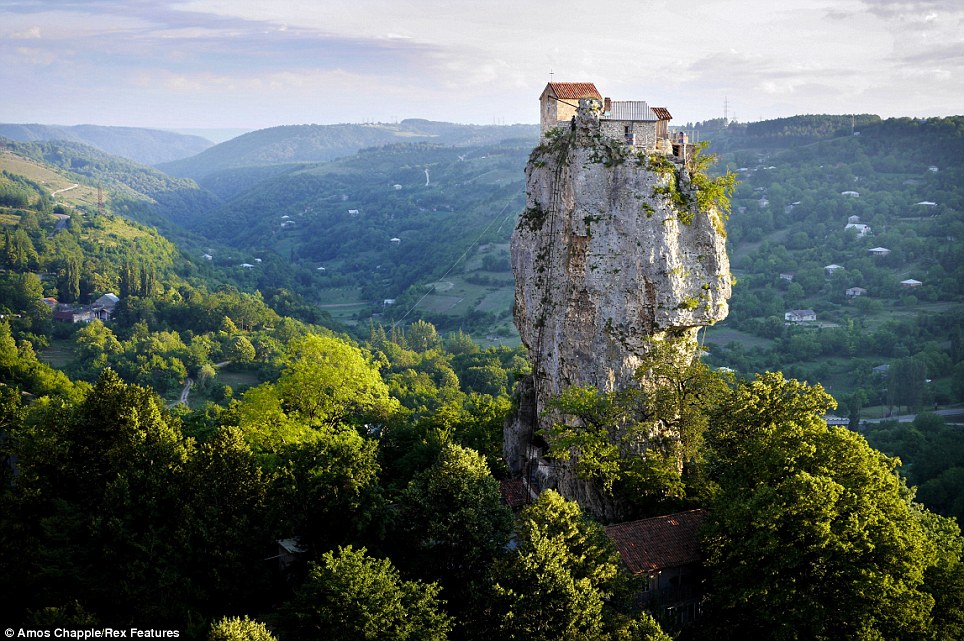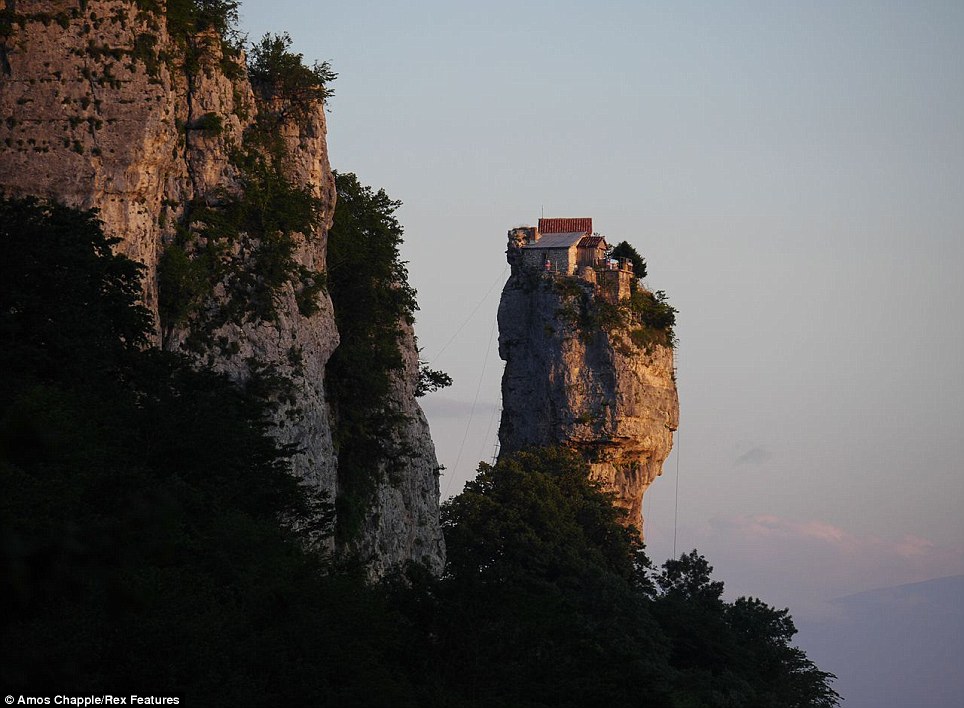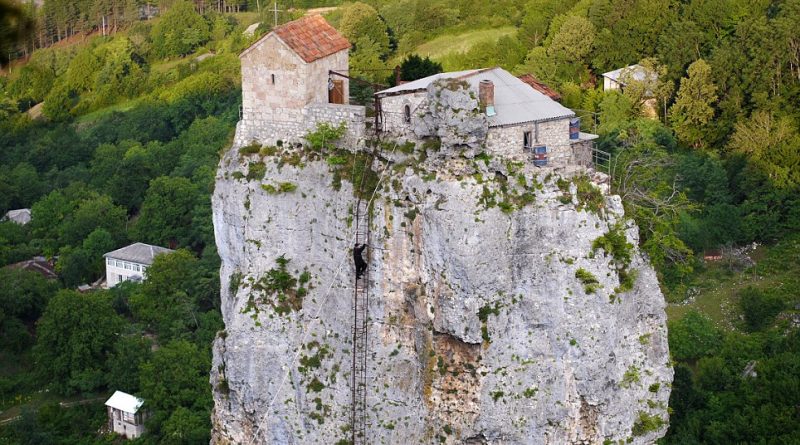Katskhi Pillar – Most Incredible Cliff Church in the World
The Katskhi pillar (Georgian: კაცხის სვეტი, kac’xis svet’i) is a natural limestone monolith located at the village of Katskhi in western Georgian region of Imereti, near the town of Chiatura. It is approximately 40 metres (130 ft) high, and overlooks the small river valley of Katskhura, a right affluent of the Q’virila.
The rock, with visible church ruins on a top surface measuring c. 150 m2, has been venerated by locals as the Pillar of Life and a symbol of the True Cross, and has become surrounded by legends. It remained unclimbed by researchers and unsurveyed until 1944 and was more systematically studied from 1999 to 2009. These studies determined the ruins were of an early medieval hermitage dating from the 9th or 10th century. A Georgian inscription paleographically dated to the 13th century suggests that the hermitage was still extant at that time. Religious activity associated with the pillar was revived in the 1990s and the monastery building had been restored within the framework of a state-funded program by 2009.

The Katskhi Pillar abruptly rises 40 meters from the hills of Central Georgia and looks similar to a giant’s club. Its mythical aura made it a place of worship since humans settled this area. Prior to the arrival of Christianity, the pillar served as a pagan holy place for a long time and was most likely used for fertility rites.
In the 4th century, Georgia adapted Christianity as its state religion, as the second country in the world after Armenia. Slowly, and following in a general world trend, Christianity replaced pagan places of worship with Christian ones to consolidate the new set of beliefs. Thus, the Katskhi Pillar became the site of a small church first built in the 7th century.
The church that sits atop the pillar resembles the practice of the Stylites who were early Christian ascetics who prayed on top of wooden pillars. Following the lead of the much-revered Saint Simeon Stylites, who sat atop a pillar for almost 40 years, these pious Christians tortured their bodies and devouted their spirit to their religion. The Katskhi Pillar also bears a striking resemblance to the famous Greek monasteries of Meteora.
Currently, the Georgian Orthodox Church is building a new small church at the top of the rock column, which is reached via a combination of scaffolding at the lower half, and a vertigo-inducing iron ladder at the upper half of the pillar. The earthly remains of a believer, who died atop the pillar at an unknown date, are kept at the contemporary church building. Women are not allowed to climb to the top.
The Katskhi Pillar is the name given to a natural limestone column located in Georgia. On the top of this monolith is a monastery, which was built during the 1990s. Today, a solitary monk by the name of Maxime Qavtaradze lives in this monastery atop the Katskhi Pillar. Nevertheless, it has been established that the pillar had been used by Christian ascetics as early as the 6th – 8th century A.D. In a way, Maxime may be said to be continuing this ancient ascetic tradition, and may even be the last one to do so on top of the Katskhi Pillar.
Location and First Function of the Katskhi Pillar
The Katskhi Pillar is situated in Imereti, which is a region in the western part of Georgia. This pillar rises to a height of about 40 meters (131.23 ft.), and overlooks the small river valley of Katskhura. As the Katskhi is such a prominent feature in the landscape, it is unsurprising that people attached special meaning to it. Prior to the coming of Christianity, for example, the Katskhi Pillar was believed to have been used as a sacred site by pagans, as early as 2,000 years ago. The monolith was thought to represent a local god of fertility, and hence fertility rites were carried out there.
But one man has taken his devotion to new heights, literally. Maxime Qavtaradze, a 59-year-old monk, has lived a life of virtual solitude on top of a pillar high above his Georgian monastry for 20 years. When he wants to leave Katskhi Pillar, he spends 20 minutes getting down a 131ft ladder. Supplies are winched up to him by his followers and he only comes down twice a week to pray with his followers. But having worked as a crane operator before taking his orders in 1993, Maxime has always had a head for heights.

He said: ‘It is up here in the silence that you can feel God’s presence.’
His only visitors are priests and a group of troubled young men who are seeking solace in the monastry at the foot of the pillar. A photographer called Amos Chapple paid a visit to Stylite monk Maxime but was not at first allowed up onto the pillar. Instead he had to spend four days taking part in seven hours of daily prayers including a four hour stint from 2am until sunrise. When he finally was granted permission to scale the ‘dicey’ ladder to the top, he was worried that it might be too dark to get back down. After making it to the top, Maxime told Amos that he became a monk after a stretch in prison and decided he wanted to make a change.
The monk slept in a fridge when he first moved to the top of the pillar, but now has a bed inside a cottage. The Katskhi Pillar was used by stylites, Christians who lived on top of pillars to avoid worldly temptation until the 15th century when the practice was stopped following the Ottoman invasion of Georgia.
For centuries the 40 metres (130ft) high pillar lay abandoned and locals could only look up at the mysterious ruins at its summit. Finally, in 1944 a group led by the mountaineer Alexander Japaridze made the first documented ascent of the pillar and discovered the remains of a chapel and the skeleton of a stylite who had perished there.
Shortly after the collapse of communism, and the subsequent resurgence of religion in Georgia, Maxime decided to live atop the pillar in the way of the old stylites. He said: ‘When I was young I drank, sold drugs, everything. When I ended up in prison I knew it was time for a change. ‘I used to drink with friends in the hills around here and look up at this place, where land met sky.
‘We knew the monks had lived up there before and I felt great respect for them’.
In 1993 Maxime took monastic vows and climbed the pillar to begin his new life. ‘For the first two years there was nothing up here so I slept in an old fridge to protect me from the weather.’ Since then Maxime and the Christian community in the area have constructed a ladder to the top, rebuilt the church, and built a cottage where Maxime spends his days praying, reading, and ‘preparing to meet god’.
As a result of the interest in the site there is now a religious community at the base of the pillar.



